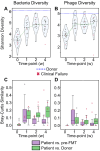Use of proximity ligation shotgun metagenomics to investigate the dynamics of plasmids and bacteriophages in the gut microbiome following fecal microbiota transplantation
- PMID: 40948444
- PMCID: PMC12439552
- DOI: 10.1080/19490976.2025.2559019
Use of proximity ligation shotgun metagenomics to investigate the dynamics of plasmids and bacteriophages in the gut microbiome following fecal microbiota transplantation
Abstract
Proximity ligation shotgun metagenomics facilitate the analysis of the relationships between mobile genetic elements, such as plasmids and bacteriophages, and their specific bacterial hosts. We applied this technique to investigate the changes in the fecal microbiome of patients receiving fecal microbiota transplantation (FMT) for recurrent Clostridioides difficile infections (rCDI). FMT was associated with successful engraftment of donor bacteria along with their associated bacteriophages. While fecal microbial diversity increased in all patients, the extent of specific bacterial taxa engraftment varied among individual patients. Interestingly, some donor bacteriophages remained closely linked to their original bacterial hosts, while others expanded their associations across different bacterial taxa. Notably, FMT partially reduced the content of vancomycin resistance and extended-spectrum beta-lactamase genes in the fecal microbiome of rCDI patients.
Keywords: Clostridioides difficile; Proximity ligation shotgun metagenomics; antimicrobial resistance genes; fecal microbiota transplantation.
Conflict of interest statement
A.K. has intellectual properties pertaining to purification, lyopreservation, and encapsulation of fecal microbiota. Phase Genomics, Inc. is a company commercializing metagenomics technology used in this study.
Figures





References
-
- Paramsothy S, Kamm MA, Kaakoush NO, Walsh AJ, van den Bogaerde J, Samuel D, Leong RWL, Connor S, Ng W, Paramsothy R, et al. Multidonor intensive faecal microbiota transplantation for active ulcerative colitis: a randomised placebo-controlled trial. Lancet. 2017;389(10075):1218–1228. doi: 10.1016/S0140-6736(17)30182-4. - DOI - PubMed
-
- Costello SP, Hughes PA, Waters O, Bryant RV, Vincent AD, Blatchford P, Katsikeros R, Makanyanga J, Campaniello MA, Mavrangelos C, et al. Effect of fecal microbiota transplantation on 8-week remission in patients with ulcerative colitis: a randomized clinical trial. JAMA. 2019;321(2):156–164. doi: 10.1001/jama.2018.20046. - DOI - PMC - PubMed
-
- Moayyedi P, Surette MG, Kim PT, Libertucci J, Wolfe M, Onischi C, Armstrong D, Marshall JK, Kassam Z, Reinisch W, et al. Fecal microbiota transplantation induces remission in patients with active ulcerative colitis in a randomized controlled trial. Gastroenterology. 2015;149(1):102–109.e6. doi: 10.1053/j.gastro.2015.04.001. - DOI - PubMed
MeSH terms
Grants and funding
LinkOut - more resources
Full Text Sources
